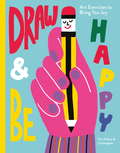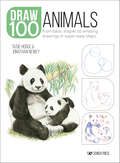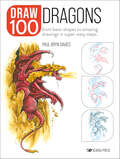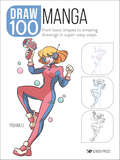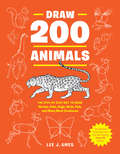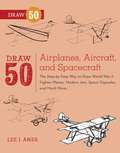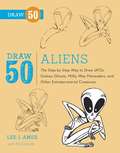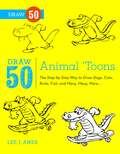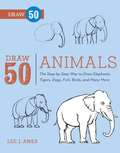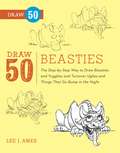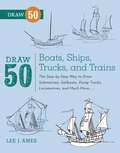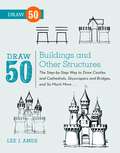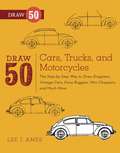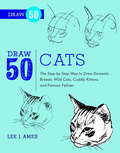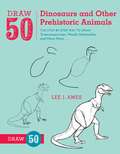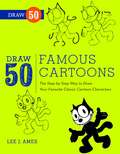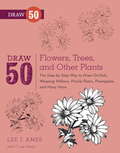- Table View
- List View
Draw & Be Happy: Art Exercises to Bring You Joy
by Tim A ShawAny time you need a moment of calm or a boost of energy, reach for this book and your best pen or pencil.Inspired by real art-therapy techniques, each of these fun and thought-provoking drawing exercises will help reduce stress, boost your confidence and leave you feeling creative and contented. These quirky creativity prompts offer simple strategies for self expression and self care to help you be happy.
Draw 100: Animals
by Susie HodgeDiscover 100 wonderful and majestic creatures to draw!Whether you have your favourites already, or are looking for inspiration from a range of diverse habitats including rainforests, mountains, polar regions or the African savannah, you're bound to discover an animal in this book that you will find irresistible – and you will just want to pick up your pencil and start drawing!Each animal is broken down into three or four simple stages that lead you effortlessly through to the finished drawing. There are no written instructions to follow – just basic shapes and pencil strokes. Even if you’ve never drawn anything before, you will be amazed at how quickly you will achieve incredibly impressive drawings. Every project also shows two finished examples of the animal – one shaded with pencil and the other with colour.This is the perfect book for budding artists yearning to draw their favourite animals.The material in this book is taken from the following books in Search Press's successful How to Draw series: Mountain Animals, Polar Animals, Rainforest Animals, African Animals.
Draw 100: Dragons
by Paul Bryn DaviesEnter the dragon's den and draw every claw, tooth and scale!From fire-breathing monsters to majestic sea serpents, Paul Bryn Davies' boundless imagination will inspire you to draw like you never have before. Start off simple with playful hatchlings and soon you'll be illustrating battling giants and gnarled wyverns. There are 100 deadly dragons to choose from, and every project is broken down into a handful of simple stages that lead you effortlessly through to the finished coloured drawing. There are no written instructions to follow – just basic shapes and pencil strokes. You'll be amazed at how easily you can create stunning, detailed drawings roaring with character!This is the perfect book for budding artists who want to create their own mythical masterpiece.
Draw 100: Flowers
by Janet WhittleEverybody loves flowers, and here are 100 beautiful blooms for you to draw!Whether you prefer the understated beauty of a simple daisy or the garish good looks of a flamingo lily, you're bound to discover a flower in this book that you will find irresistible – and you will just want to pick up your pencil and start drawing! There are everyday garden blooms such as roses and tulips, delicate wild varieties such as primroses and bluebells, and a whole range of exotics, too, if you want to try something a bit different.Each flower is broken down into six simple stages that lead you effortlessly through to the finished drawing. There are no written instructions to follow – just basic shapes and pencil strokes. Even if you’ve never drawn anything before, you will be amazed at how quickly you will achieve incredibly impressive drawings. Every project also shows two finished examples of the flower – one shaded with pencil and the other with colour.This is the perfect book for budding artists yearning to draw their favourite posies, or the experienced artist looking for a variety of subjects to inspire.The material in this book is taken from the following books in Search Press's successful How to Draw series: Flowers, Garden Flowers, Wild Flowers, Exotic Flowers.
Draw 100: Manga
by Yishan LiMaster manga with 100 creatures, characters and super-cute chibis.This is the ultimate introduction to drawing manga: 100 simple, step-by-step drawings of everything from superheroes to super-cute pets. Practise drawing different hair and facial expressions then create your own elaborate and colourful manga characters; draw up a battling universe of manga superheroes and villains; start your own collection of super-cute chibi chums.Whether you're looking for inspiration or just getting started, professional comic creator Yishan Li will be your guide.Every project is broken down into a handful of simple stages that lead you effortlessly through to the final coloured drawing. There are no written instructions to follow – just basic shapes and pencil strokes. Even if you’ve never drawn anything before, you will be amazed at how quickly you will achieve your own cute and characterful manga drawings!This title contains content from two books in the How to Draw series: Manga Heroes and Manga Faces.
Draw 200 Animals: The Step-by-Step Way to Draw Horses, Cats, Dogs, Birds, Fish, and Many More Creatures
by Lee J. AmesA compendium of step-by-step drawing exercises from the best-selling Draw 50 series that features easy-to-follow lessons for rendering animals including cats, dogs, horses, prehistoric creatures, and more.With exercises taken from the animal drawing instruction titles in Lee J. Ames's beloved Draw 50 series, Draw 200 Animals brings you the best of Draw 50 Animals, Draw 50 Cats, Draw 50 Dogs, Draw 50 Horses, and Draw 50 Dinosaurs and Other Prehistoric Animals in a must-have collection of easy-to-follow, step-by-step visual lessons on sketching and rendering all kinds of furry, feathered, and finned critters. These classic lessons show you how to draw everything from pets to wild animals, including birds, insects, elephants, tigers, and more, in styles ranging from realistic to cartoony.
Draw 50 Airplanes, Aircraft, and Spacecraft: The Step-by-Step Way to Draw World War II Fighter Planes, Modern Jets, Space Capsules, and Much More... (Draw 50)
by Lee J. AmesWorld War I bombers, rocket launchers and all types of flying machines are represented here in step-by-step drawings. An American Bookseller Pick of the Lists.
Draw 50 Aliens: The Step-by-Step Way to Draw UFOs, Galaxy Ghouls, Milky Way Marauders, and Other Extraterrestrial Creatures (Draw 50)
by Lee J. Ames Ric EstradaAlien fever is running high: the Alien movies and reissue of the Star Wars trilogy have made outer space fascinating to a whole new generation of children. And who better to help budding artists master their drawings of the friendly folk from the final frontier than Lee Ames--creator of the phenomenally successful Draw 50 series?An ideal tool for young artists or the parent or teacher seeking to help a child master their artistic skills, Draw 50 Aliens includes creatures from every walk of the galaxy: Ames gives instructions for drawing UFOs, Nebula Nomads, Milky Way Marauders, and every other type of extraterrestrial. And, in the tradition of the Draw 50 series, all of these characters are humorous, lovable, and very accessible for children.With over two million copies in print, the Draw 50 series has successfully shown children how to create everything from a robin to a spaceship, Tyrannosaurus rex to John the Baptist. But with Draw 50 Aliens, Ames has--perhaps as never before--hit upon a deeply appealing subject, one that taps into children's sense of wonder and will keep them endlessly entertained and forever sketching away.From the Trade Paperback edition.
Draw 50 Animal 'Toons: The Step-by-Step Way to Draw Dogs, Cats, Birds, Fish, and Many, Many More (Draw 50)
by Lee J. Ames Bob SingerDraw 50 Animal 'Toons shows aspiring artists how to draw with ease by following simple, step-by-step instructions. Acclaimed author Lee J. Ames helps you bring to life a skateboarding crocodile, a funky monkey, and a juggling seal. Also included are dinosaurs, flamingos, squirrels, gorillas, and a whole spectrum of fun-loving animals.Lee J. Ames's drawing method has proven successful for children and adults alike over the past thirty years. The twenty-seven books in the Draw 50 series have sold more than 3 million copies and have shown everyone from amateurs to experts how to draw everything from animals to airplanes.Even the youngest artists can make these 'toons look great. It's easy to draw cartoon animals when you do it the Draw 50 way.From the Trade Paperback edition.
Draw 50 Animals: The Step-by-Step Way to Draw Elephants, Tigers, Dogs, Fish, Birds, and Many More (Draw 50)
by Lee J. AmesFifty furry, scaly and feathered friends are here for aspiring young artists to draw.
Draw 50 Athletes: The Step-by-Step Way to Draw Wrestlers and Figure Skaters, Baseball and Football Players, and Many More... (Draw 50)
by Lee J. AmesFavorite athletes from sports such as baseball, basketball, football, tennis, skiing, gymnastics and track-and-field are presented here. An American Bookseller Pick of the Lists, New York Public Library -- Books for the Teen Age.From the Trade Paperback edition.
Draw 50 Baby Animals: The Step-by-Step Way to Draw Kittens, Lambs, Chicks, Puppies, and Other Adorable Offspring (Draw 50)
by Lee J. Ames Murray ZakRevisiting the animal theme that kicked off the series more than twenty-five years ago, Draw 50 Baby Animals brings you an amazing array of the most adorable critters on earth. This latest installment in the Lee J. Ames illustration dynasty features darling baby animals from the wild, the barnyard, and even the backyard that will delight children and parents alike, making it an ideal tool for mastering drawing skills either at home or at school. Lee J. Ames's signature step-by-step method shows you how to draw the cutest offspring in the animal kingdom with ease from a fluffy chick and a shaky-legged fawn to playful puppies and sweet-faced kittens. His clear instructions help budding artists to explore their interests in a fun, familiar (and loveable!) way. With over three million copies in print, the Draw 50 series has successfully shown children how to create everything from a robin to a spaceship, Tyrannosaurus Rex to skyscrapers, and UFOs to racing cars. Draw 50 Baby Animals is sure to captivate a new generation of artists and keep them endlessly entertained, sketching their newfound friends.
Draw 50 Beasties: The Step-by-Step Way to Draw 50 Beasties and Yugglies and Turnover Uglies and Things That Go Bump in the Night (Draw 50)
by Lee J. Ames"With its popular subject of imaginative monsters and other nightmare inhabitants, [this] will be a sure-fire circulator." -- Publisher's Weekly.From the Trade Paperback edition.
Draw 50 Birds: The Step-by-Step Way to Draw Chickadees, Peacocks, Toucans, Mallards, and Many More of Our Feathered Friends (Draw 50)
by Lee J. Ames Tony D'AdamoDraw 50 Birds teaches aspiring artists how to draw with ease by following simple, step-by-step instructions. Celebrated author Lee J. Ames brings together dozens of birds from around the world, including the puffin, the peacock, the dodo bird, the dove, the great horned owl, and even the common chicken. Ames's illustration style and renowned drawing method has made him a leader in the step-by-step drawing manual, and the 31 books in his Draw 50 series have sold more than three million copies. Ames's instruction allows seasoned artists to refine their technique and guides amateurs to develop their own artistic abilities. Even the youngest artists can make these feathered friends. It's easy to enjoy the company of your favorite feathered friends when it's done the Draw 50 way.
Draw 50 Boats, Ships, Trucks, and Trains: The Step-by-Step Way to Draw Submarines, Sailboats, Dump Trucks, Locomotives, and Much More... (Draw 50)
by Lee J. AmesDraw 50 Boats, Ships, Trucks, and Trains teaches aspiring artists how to draw with ease by following simple, step-by-step instructions. Celebrated author Lee J. Ames shows readers how to draw dozens of modes of transportation from throughout history, such as a Viking ship and the Santa Maria, as well as a nuclear submarine, a Jeep, and a tractor-trailer. Ames's illustration style and renowned drawing method has made him a leader in the step-by-step drawing manual, and the 31 books in his Draw 50 series have sold more than three million copies. Ames's instruction allows seasoned artists to refine their technique and guides amateurs to develop their own artistic abilities. Even the youngest artists can make any type of vehicle look great. It's easy to build all kinds of vehicles when it's done the Draw 50 way.
Draw 50 Buildings and Other Structures: The Step-by-Step Way to Draw Castles and Cathedrals, Skyscrapers and Bridges, and So Much More... (Draw 50)
by Lee J. AmesDraw 50 Buildings and Other Structures teaches aspiring artists how to draw with ease by following simple, step-by-step instructions. Celebrated author Lee J. Ames shows readers how to draw famous structures from all over the world, as well as an igloo, a barn and silo, a windmill, and even a teepee. Ames's illustration style and renowned drawing method has made him a leader in the step-by-step drawing manual, and the 31 books in his Draw 50 series have sold more than three million copies. Ames's instruction allows seasoned artists to refine their technique and guides amateurs to develop their own artistic abilities. Even the youngest artists can draw the tallest, grandest structures. It's easy to construct any type of building when it's done the Draw 50 way.
Draw 50 Cars, Trucks, and Motorcycles: The Step-by-Step Way to Draw Dragsters, Vintage Cars, Dune Buggies, Mini Coopers Choppers, and Many More... (Draw 50)
by Lee J. AmesProvides step-by-step instructions on how to draw a variety of cars, trucks, and motorcycles, including Ford Thunderbird, dump trucks, and minibikes.
Draw 50 Cats
by Lee J. AmesThis book brings to life Siamese, Persians, lions, tigers, panthers and such celebrity felines as Felix, Top Cat and Snaggle Puss.From the Trade Paperback edition.
Draw 50 Creepy Crawlies: The Step-by-Step Way to Draw Bugs, Slugs, Spiders, Scorpions, Butterflies, and Many More... (Draw 50)
by Lee J. Ames Ray BurnsDraw 50 Creepy Crawlies teaches aspiring artists how to draw with ease by following simple, step-by-step instructions. Celebrated author Lee J. Ames shows you how to draw a swarm of flying and crawling creatures. Here, you'll find dozens of insects and spiders, such as the housefly, firefly, black widow, ladybug, caterpillar, butterfly, and others. There are even snails, fleas, and centipedes! Ames's illustration style and renowned drawing method has made him a leader in the step-by-step drawing manual, and the 31 books in his Draw 50 series have sold more than three million copies. Ames's instruction allows seasoned artists to refine their technique and guides amateurs to develop their own artistic abilities. Even the youngest artists can make these bugs look great. It's easy to learn all about these peculiar creatures when it's done the Draw 50 way.
Draw 50 Dinosaurs and Other Prehistoric Animals: The Step-by-Step Way to Draw Tyrannosauruses, Woolly Mammoths, and Many More... (Draw 50)
by Lee J. AmesThe tyrannosaurus rex, brachiosaurus, triceratops and moa burst out in terrifying splendor to the delight of all dinosaur fans. With a foreword by George Zappler, Director of the Staten Island Zoological Society. An American Bookseller Pick of the Lists.From the Trade Paperback edition.
Draw 50 Dogs: The Step-by-Step Way to Draw Beagles, German Shepherds, Collies, Golden Retrievers, Yorkies, Pugs, Malamutes, and Many More... (Draw 50)
by Lee J. AmesOld English sheep dogs, German Shepherds and Malamutes are just a few of the fun-loving, furry breeds that anyone can create by following these sketches. An American Bookseller Pick of the Lists.From the Trade Paperback edition.
Draw 50 Endangered Animals
by Lee J. Ames Warren BuddDraw 50 Endangered Animals teaches artists of all levels how to draw with ease by following simple, step-by-step examples. Celebrated author Lee J. Ames has brought together an assortment of animals whose numbers are threatened, including classic favorites such as the giant panda, the humpback whale, and the Asian elephant. However, you'll also find animals you may never have heard of, like the vicuña, Przewalski's horse, and the Everglade snail kite. Ames's drawing method has proven successful for children and adults of all ages over the past 40 years. The 31 books in the Draw 50 series have sold more than three million copies and have shown artists, from the beginner to advanced levels, how to draw everything from animals to airplanes. It's easy to cherish our feathered, furry, and scaly friends when it's done the Draw 50 way.
Draw 50 Famous Cartoons: The Step-by-Step Way to Draw Your Favorite Classic Cartoon Characters (Draw 50)
by Lee J. AmesA barrel of laughs is what aspiring cartoonists of all ages will have while they learn to draw their favorite characters from the funny pages.From the Trade Paperback edition.
Draw 50 Flowers, Trees, and Other Plants
by Lee J. Ames P. Lee AmesOffers easy-to-follow, step-by-step instructions for drawing a wide variety of plants, including such favorites as roses and orchids, as well as more unusual types like the baobab tree and the prickly pear cactus.
